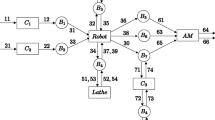Abstract
This paper presents the design, development, and implementation of an integrated control framework that provides a real-time supervisory control model with limited look-ahead capability for flexible manufacturing systems. Control goals and policies are modeled and characterized by a fuzzy rule base, which is integrated with the control model. The framework consists of a finite state machine generator and a controller. The generator model is equipped with an output function and output sets. The controller model has a four-stage decision-making structure. The controller monitors performance measures of the manufacturing system and reacts according to the changes in the system states in order to keep the performance measures at desired levels. The integrated framework has been implemented on a software platform in order to validate its effectiveness. The performance of the framework has been tested on a hypothetical flexible manufacturing system using a simulation .
Similar content being viewed by others
References
Saygin C, Kilic SE (1999) Integrating flexible process plans with scheduling in flexible manufacturing systems. Int J Adv Manuf Technol 15(4):268-280
Kim S, Park JR, Leachman C (2001) A supervisory control approach for execution control of an FMC. Int J Flexible Manuf Syst 13:5–13
Siwamogsatham T, Saygin C (2004) Analysis of an auction-based distributed scheduling scheme for a flexible manufacturing system. Int J Prod Res 42(3):547–572
Balduzzi F, Menga G (1998) A state variable model for the fluid approximation of flexible manufacturing systems. In: Proceedings of the 1998 IEEE International Conference on Robotics and Automation, Leuven, Belgium, pp 1172–1178
Saygin C, Chen FF, Singh J (2001) Real-time manipulation of alternate routings in flexible manufacturing systems: a simulation study. Int J Adv Manuf Technol 18(10):755–763
Maier-Speredelozzi V, Hu SJ (2002) Selecting manufacturing system configurations based on performance using AHP. Trans NAMRI/ SME:637–644
Harmonosky CM, Farr RH, Ni M-C (1997) Selective rerouting using simulated steady state system data. In: Proceedings of the 1997 Winter Simulation Conference, pp 1293–1298
Fujimoto H, Yasuda K, Tanigawa Y, Iwahashi K (1998) Applications of generic algorithm and simulation to dispatching rule-based FMS scheduling. In: Proceedings of the 1995 IEEE International Conference on Robotics and Automation, pp 190–195
Kotak D, Bardi S, Gruver WA, Zohrevand K (2000) Comparison of hierarchical and holonic shop floor control using a virtual manufacturing environment. In: Proceedings of the 2000 IEEE International Conference on Systems, Man, and Cybernetics, pp 1667–1672
Wang Y-F, Cruz JB Jr, Mulligan JH Jr (1994) Adaptive scheduling utilizing a neural network structure. In: Proceedings of the 1994 IEEE World Congress on Computational Intelligence, 1994 IEEE International Conference Neural Networks 6(27):3806–3811
Dadone P, Vanlandingham HF (1998) Fuzzy control of flexible manufacturing systems. In: Proceedings of ANNIE’98, St. Louis, Missouri, pp 867–872
Xiang D, O’Brien C (1994) Cell control research: current status and development trends. Int J Prod Res 33:2325–2352
Ramadge PJ, Wonham WM (1987) Supervisory control of a class of discrete event process. Siam Control Optim 25:206–230
Nourelfath M (2000) The real-time monitoring of an experimental manufacturing cell. In: Proceedings of the IEEE Canadian Conference on Electrical and Computer Engineering, Canada, pp 297–301
Ramadge PJ, Wonham WM (1989) The control of discrete event systems. In: Proceedings of the IEEE 77(1):81–98
Brandin BA (1996) The real-time supervisory control of an experimental manufacturing cell. IEEE Trans Robot Automat 12(1):1–14
Gohari P, Wonham WM (2003) Reduced supervisors for timed discrete-event systems. IEEE Trans Automatic Control 48(7):1187–1198
Ho TJ (2000) The synthesis of controllers to handle safety and liveness for timed discrete-event systems – an example in nuclear reactor systems. In: Proceedings of the IEEE International Conference on Control Applications, Alaska, pp 604–609
Brandin BA, Wonham WM (1994) Supervisory control of timed discrete event systems. IEEE Trans Automat Control 39(2):329–342
Lin F, Ying H (2001) Fuzzy discrete event systems and their observability. In: Proceedings of the 9th IFSA World Congress and 20th NAFIPS International Conference 3:1271–1276
Kumar R, Garg V K (1995) Optimal supervisory control of discrete event dynamical systems. Siam J Control Optimi 33(2):491–439
Chandra V, Kumar R (2001) A new modeling formalism and automata model generator for a class of discrete event systems. In: Proceedings of the American Control Conference, Arlington, VA, pp 1–25.
Sengupta R, Lafortune S (1998) An optimal control theory for discrete event systems. Siam J Control Optim 36(2):488–541
Chung S-L, Lafortune S, Lin F (1992) Limited look-ahead policies in supervisory control of discrete event systems. IEEE Trans Automat Control 37(12):1921–1935
Hadj-Alouane NB, Lafortune S, Lin F(1994) Variable look-ahead supervisory control with state information. IEEE Trans Automat Control 39(12):2398–2410
Heymann M, Lin F (1998) Online control of partially observed discrete event systems. Discret Event Dyn Syst: Theory Appl 4(3):221–236
Ying M (2002) A formal model of computing with words. IEEE Trans Fuzzy Syst 10(5):640–652
Zadeh L A (1965) Fuzzy sets. Inf Control 8:338–353
Zadeh L A (1990) Outline of a new approach to the analysis of complex systems. IEEE Syst Man Cybernet SMC-3:404–435
Hennequin S, Lefebvre D, El Moudni A (2001) Fuzzy multimodel of timed Petri nets. IEEE Syst Man Cybernet 31(2):245–251
Naso D, Maione G (2001) Recent developments in the application of computational intelligence to multi-agent manufacturing control. In: Proceedings of the IEEE Conference on Fuzzy Systems, pp 990–994
Dadone P, Vanlandingham HF (1998) Fuzzy control of flexible manufacturing systems. In: Proceedings of ANNIE’98, St. Louis, Missouri, pp 867–872
Kandel A, Langholz G (1994) Fuzzy control systems. CRC Press, Boca Raton
Durkin J (1994) Expert systems. Macmillan, New York
Author information
Authors and Affiliations
Corresponding author
Rights and permissions
About this article
Cite this article
Buyurgan, N., Saygin, C. An integrated control framework for flexible manufacturing systems. Int J Adv Manuf Technol 27, 1248–1259 (2006). https://doi.org/10.1007/s00170-004-2311-4
Received:
Accepted:
Published:
Issue Date:
DOI: https://doi.org/10.1007/s00170-004-2311-4




